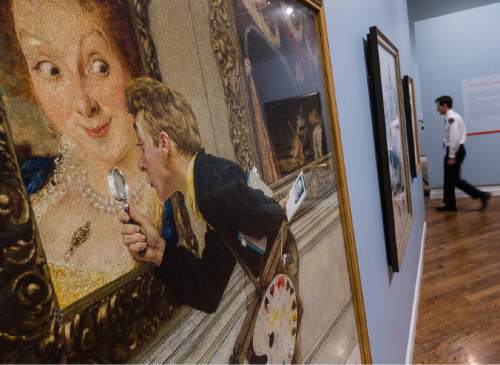This is an archived article that was published on sltrib.com in 2015, and information in the article may be outdated. It is provided only for personal research purposes and may not be reprinted.
Provo • For people who hear the name Norman Rockwell and think of precocious kids and rosy-cheek Santa Clauses, the exhibit opening today at the Brigham Young University Museum of Art will be a jolt.
Sure, the artist's famous images of Americana abound in the exhibit, "American Chronicles: The Art of Norman Rockwell," which features 50 Rockwell originals and copies of all 323 covers he created for The Saturday Evening Post from 1916 to 1963.
But the exhibit, running through Feb. 13, also spotlights how Rockwell applied his art to politics and social issues — notably the civil-rights movement.
Patrons may be "surprised by how intense these paintings are," said Kylie M. Brooks, the museum's publicity and PR manager during a preview Thursday.
The centerpiece of the exhibit is Rockwell's 1964 painting "The Problem We All Live With," first published in Look magazine in 1964. The work depicts a pivotal moment from the civil-rights movement from 1960, when 6-year-old Ruby Bridges became the first black student in an all-white school in New Orleans.
Bridges, now 61, told an audience at BYU on Thursday night that she didn't know Rockwell personally, but she thinks she knows what the artist intended.
"Here was a person who probably didn't know what to do [about racism] like we do," Bridges said. "He used his gift, and he painted these very powerful images. … He took a lot of flak for that, but he did it."
The painting shows the young Bridges walking among four U.S. marshals. The spray of a poorly aimed tomato is splattered on the wall in the background, punctuating the N-word scrawled there.
"We see Ruby in her white dress; she's ready to go to school. And it's juxtaposed with the horrible things happening around her," Brooks said. "It's remarkable, her story."
Bridges told that story to a packed house at the museum Thursday evening, recounting her first day at William Frantz Elementary School. She was driven by federal marshals, escorted by neighbors and faced a crowd of white protesters.
"My first thought [then] was, 'It's Mardi Gras. I'm in a parade,' " Bridges said in a moving lecture, standing under a projection of Rockwell's painting of her.
The first day of school, Bridges said, she learned her biggest lesson. It came when she met her teacher, Mrs. Henry, whose skin was the same white as the angry protesters' outside.
Bridges learned, she said, "I cannot judge a person by looking at them. I have to give myself the opportunity to get to know them."
Today, Bridges, as founder of the Ruby Bridges Foundation, speaks to schools around the country, advocating against racism and bullying. The children she meets, she said, identify with how she felt when she was Mrs. Henry's only student.
"They put themselves in the shoes of this little girl," Bridges said. "They can relate to the loneliness, the pain, of someone saying they don't like you, or bullying you for no reason at all."
Rockwell's interest in racial equality began early, Brooks said. One painting in the exhibit, "Boy in a Dining Car" (1947), shows a child eating on a train, attended by a black porter. Rockwell was irritated by The Saturday Evening Post's rule that black figures could only be depicted in subservient roles, Brooks said.
Rockwell ended his association with The Post in 1963, in part because of age (he was nearly 70) and in part over political differences. His last cover for The Post ran just after John F. Kennedy's assassination: A reprint of a portrait of JFK, first published just before his election in 1960.
Another painting from the civil-rights era, "Murder in Mississippi" (1964), depicts the murders on June 21, 1964, of civil-rights campaigners Michael Schwerner, Andrew Goodman and James Chaney, killed by Ku Klux Klan members near Philadelphia, Miss.
Rockwell created the stark work, monochromatic except for the blood, "so people could see what he felt about this incident," Brooks said.
Twitter: @moviecricket











